The strangest cemetery in Andalusia is in Malaga: were the dead buried standing up?

Much is said about the monumentality that can be seen in certain cemeteries . There are pantheons, tombstones, and niches that feature sculptures of great artistic quality, making these places a must-see for travelers.
If you add to all this the oral tradition that says the dead were buried standing up ... the interest increases. This is the case of the cemetery in the town of Casa Bermeja, Malaga.
It dates back to the 18th century and can be seen from the road, as the highest tombs rise above normal level. This is why this legend began to develop.
However, its real origin is another: the town cemetery became too small because the municipality was growing, and the one that is still preserved was built, although the residents did not want to be buried there due to the distance from God and the Church. King Charles III issued an order that burials would be in this place. But to compensate for this distance, the niches began to be arranged around the hermitage of San Sebastián , just as the town houses were arranged around the church, and a small inland town began to take shape.
 View of the streets of the Casa Bermeja cemetery
Andalusian government
View of the streets of the Casa Bermeja cemetery
Andalusian government
The legend that the dead were buried standing up is due to the architectural form of the niches in the San Sebastián cemetery, which are divided into three parts: a lower one for the deceased; a central one for the tombstone; and an upper one with decorations. Thus, when viewed from a distance from the road, the pediments seem to indicate that the dead are buried standing up, but in reality, this is not the case.
The niches are of greatest artistic value behind the chapel. They are rectangular and adjoin one another in a variety of shapes and sizes. The doorways are decorated with all kinds of classical elements, such as pilasters, moldings, and pediments, with the traditional finish being plaster and whitewash.
In the 1970s and early 1980s, the cemetery was influenced by the development brought by the new access to Málaga. Many townspeople began working on the construction and brought in scrap tiles to make cleaning easier. As the heritage and the monument were depreciating, a maintenance and conservation master plan was established, and these aspects were eliminated.
All streets are paved with cobblestones and cement mortar, and the sidewalks are paved with clay and brick paving.
Regarding the chapel, it should be noted that it has a triangular pediment and is crowned by a belfry housing a bell. On one side is what was formerly the autopsy room , and there is also a plaza-like space designated for offering condolences to the families of the deceased.
ABC.es





